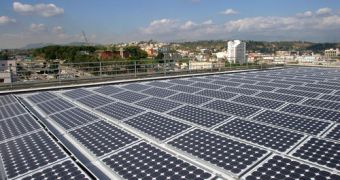Exfoliation is not only a cosmetic technique aimed at removing dead skin cells from the face and body, but it also causes the breaking up particle aggregates in material science and what promises to produce a new generation of solar cells that are much lighter and cheaper than existing models.
Researchers, from the California Institute of Technology and EMCORE PhotoVoltaics, led by James Zahler from Aonex Technologies, created a new technology for producing solar cells by replacing the thick semiconductor substrate that is currently used in creating these devices with a thin "wafer-bonded" substrate.
The new applications are much lighter than existing ones and have better characteristics than those created on bulky substrates, being just hundreds of nanometers thick instead of a few hundred microns.
Semiconductor layers are used to absorb photons from sunlight and convert them into electricity. Indium gallium arsenide (InGaAs) is usually placed on top of indium phosphide (InP) to produce fairly efficient solar cells, but rather expensive.
The new exfoliation process replaces the thick indium phosphide substrate with a very thin layer of the same material which is placed on top of an oxidized wafer of silicon, cheaper that the indium phosphide, thus cutting production costs in half.
According to Katsuaki Tanabe of Caltech, the new transferred layers is not only 900 nm thick, but it also produces a 20% higher electrical output, achieved by using the high reflectivity at the interface between the indium phosphide and the silicon.
Weight was also reduced by half, due to the fact that most of it is given by the substrate that the photovoltaic layer is grown on. The next step is to produce a solar cell containing four photovoltaic layers, which would achieve an efficiency superior to that of three-layered one.
"I find these results impressive," says Rolf Koenenkamp of Portland University in the US. "The prospects for a four-junction solar cell seem much improved, where the exfoliation technique can indeed be applied reliably and at a reasonable cost."

 14 DAY TRIAL //
14 DAY TRIAL //